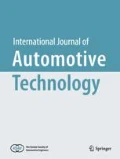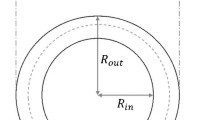Abstract
In this paper, a model for a prediction of conducted emission from vehicular PMSM-drive braking system is presented. The proposed model is based on the high-frequency circuit model combined with EM simulation. The parameter for high-frequency circuit modeling is derived from the measurement as well as 3D EM simulation based on FEM. To establish meaningful high-frequency parameters, the lumped parameters concerning the three-phase motor coil, motor busbar, heatsink, LISN, harness wire, meshed strap wire, and the passive-EMI filters including parasitics are either electromagnetically simulated or directly measured through an impedance analyzer. The distributed parameters of the PCB’s, connector, and motor housing are calculated via the 3D EM simulation. Eventually, the presented high-frequency parameters were integrated with PWM inverter circuit for the system-level analysis, and the model was verified through the correlation between the measurement and simulation with the EMI filters installed in the system. Moreover, the EMI characteristics with/without particular noise propagation path were analyzed in the model. The calculated conducted emission of the proposed model showed a very good agreement with the experimental data, which proves the validness of the proposed model.
Similar content being viewed by others
Abbreviations
- I c :
-
common mode current, A
- R s :
-
resistance of motor stator coil, Ω
- L s :
-
inductance of motor stator coil, H
- C p :
-
capacitance of coil-to-coil distributed coupling, F
- C g :
-
capacitance from stator coil to motor housing, F
- R p :
-
eddy current loss, Ω
- L b :
-
inductance of motor busbar, H
- C u :
-
capacitance of busbar-to-busbar neighbor coupling, F
- C b :
-
capacitance from busbar to motor housing, F
- ε r :
-
relative permittivity
References
Boglietti, A., Cavagnino, A. and Lazzari, M. (2007). Experimental high-frequency parameter identification of AC electrical motors. IEEE Trans. Industry Applications 43, 1, 23–29.
Guttowski, S., Weber, S., Hoene, E., John, W. and Reichl, H. (2003). EMC issues in cars with electric drives. Proc. IEEE Symp. Electromagnetic Compatibility, Boston, Massachusetts, USA.
Karanun, K., Khan-ngern, W. and Nitta, S. (2002). The characteristics of conducted EMI emission on PWM inverters with various PWM patterns. Proc. 3rd Int. Symp. Electromagnetic Compatibility, Beijing, China.
Kempski, A. (2005). EMI noise splitting into common and differential modes in PWM inverter drive system. IEEE Compatibility in Power Electronics, Gdynia, Poland.
Kempski, A., Smolenski, R. and Strzelecki, R. (2002). Common mode current paths and their modeling in PWM inverter-fed drives. Proc. 33rd Annual IEEE Power Electronics Specialists Conf., Cairns, Queensland, Australia.
Kwack, Y., Kim, H., Song, C., Moon, M., Kim, D., Kim, B., Kim, E. and Kim, J. (2015). EMI modeling method of interior permanent magnet synchronous motor for hybrid electric vehicle drive system considering parasitic and dynamic parameters. Asia-Pacific Symp. Electromagnetic Compatibility, Taipei, Taiwan.
Lee, C. and Kwon, O. (2018). A highly accurate solenoid valve driver with current sensing circuits for brake systems. IEICE Electronics Express 15, 2, 1–12.
Lee, J. S., Lee, J. J., Kim, M. R., Park, I. J., Kim, J. G., Lee, K. S. and Nah, W. (2012). Electric model of Li-ion polymer battery for motor driving circuit in hybrid electric vehicle. J. Electrical Engineering and Technology 7, 6, 932–939.
Lee, K. S. and Lee, W. T. (2015). State estimation for motorized seat belt system using sliding-mode observer. Int. J. Automotive Technology 16, 2, 301–308.
Luszcz, J. and Iwan, K. (2006). Conducted EMI propagation in inverter-fed AC motor. Electrical Power Quality and Utilisation Magazine 2, 1, 47–51.
Nanda, G. and Kar, N. C. (2006). A survey and comparison of characteristics of motor drives used in electric vehicles. Proc. Canadian Conf. Electrical and Computer Engineering, Ottawa, Canada.
Ogasawara, S. and Akagi, H. (1996). Modeling and damping of high-frequency leakage currents in PWM inverter-fed AC motor drive systems. IEEE Trans. Industry Applications 32, 5, 1105–1114.
Rostamzadeh, C., Canavero, F., Kashefi, F. and Darbandi, M. (2012). Automotive AM-band radiated emission mitigation techniques, a practical approach. Proc. IEEE Int. Symp. Electromagnetic Compatibility, Pittsburgh, Pennsylvania, USA.
Steven, G. and Pytel, Jr. (2009). Simulation Driven Product Development Aids Designers of Printed Circuit Boards in Meeting Electromagnetic Compatibility Requirements. Solutions for PCB Electromagnetic Interference — Article — ANSYS Advantage — V4 I1.
Tsuk, M. J. and Jacob, K. W. (2009). State-space Model-based Simulators and Methods. US8504345B1.
Wang, S., Lee, F. C., Chen, D. Y. and Odendaal, W. G. (2004). Effects of parasitic parameters on EMI filter performance. IEEE Trans. Power Electronics 19, 3, 869–877.
Yang, J. and Coughlin, J. F. (2014). In-vehicle technology for self-driving cars: Advantages and challenges for aging drivers. Int. J. Automotive Technology 15, 2, 333–340.
Yousaf, J., Jung, H., Kim, K. and Nah, W. (2016). Design, analysis, and equivalent circuit modeling of dual band PIFA using a stub for performance enhancement. J. Electromagnetic Engineering and Science 16, 3, 169–181.
Zang, K., Li, J., Ouyang, M., Gu, J. and Ma, Y. (2011). Electric braking performance analysis of PMSM for electric vehicle applications. Proc. Int. Conf. Electronic & Mechanical Engineering and Information Technology, Harbin, China.
Zhang, N. and Nah, W. (2016). Mode analysis of cascaded four-conductor lines using extended mixed-mode S-parameters. J. Electromagnetic Engineering and Science 16, 1, 57–66.
Zhong, E. and Lipo, T. A. (1995). Improvements in EMC performance of inverter-fed motor drives. IEEE Trans. Industry Applications 31, 6, 1247–1256.
Author information
Authors and Affiliations
Corresponding author
Additional information
Publisher’s Note
Springer Nature remains neutral with regard to jurisdictional claims in published maps and institutional affiliations.
Rights and permissions
About this article
Cite this article
Lee, J., Ha, J., Kim, M. et al. Prediction of Conducted Emission in a PMSM-Drive Braking System Using a Circuit Model Combined with EM Simulation. Int.J Automot. Technol. 20, 487–498 (2019). https://doi.org/10.1007/s12239-019-0046-3
Received:
Revised:
Accepted:
Published:
Issue Date:
DOI: https://doi.org/10.1007/s12239-019-0046-3




